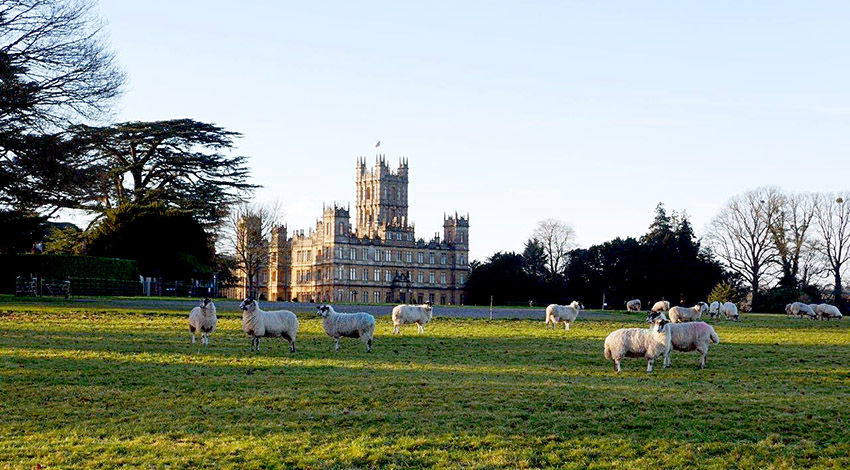
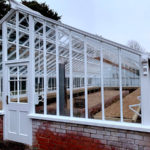
The repaired greenhouse
Last week we finally finished repairing the Victorian greenhouse behind the Monks’ Garden. Repair is a somewhat loose term here since it had to be more or less rebuilt from the first course of bricks up, given how little there was left to actually repair. In any other situation, the greenhouse would simply have been demolished, and a modern replacement installed, but it is part of our heritage at Highclere so it was restored and the Victorian system of opening the lights re-installed.
Greenhouses were always a bit of a luxury, even more so these days since we can pop down to a supermarket and find a wealth of available food options.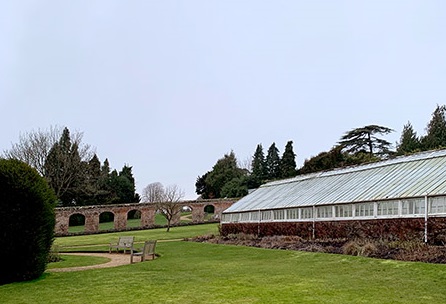
In the past though, greenhouses helped provide a little more diversity in our diet than would otherwise have been possible in this northern climate. Highclere was particularly well equipped having a melon house, a pineapple house and a vinery as well a number of greenhouses in which to grow tomatoes, peppers, peaches, apricots and so on.
The greenhouses were backed up by walled gardens, vegetable beds and orchards. Old maps and records from four or even eight hundred years ago, show that beyond the surrounding productive gardens here at Highclere was a mixed farm employing many people. Just as today, the animals enjoyed large areas of good, sheltered pasture, there was and is long rotation with variety of arable crops as well as downland and woodland. The dairy herd was based near the walled garden as it would provide excellent compost later and it was easy for the fresh milk to be delivered to the kitchens and dairies next door to make the cheese.
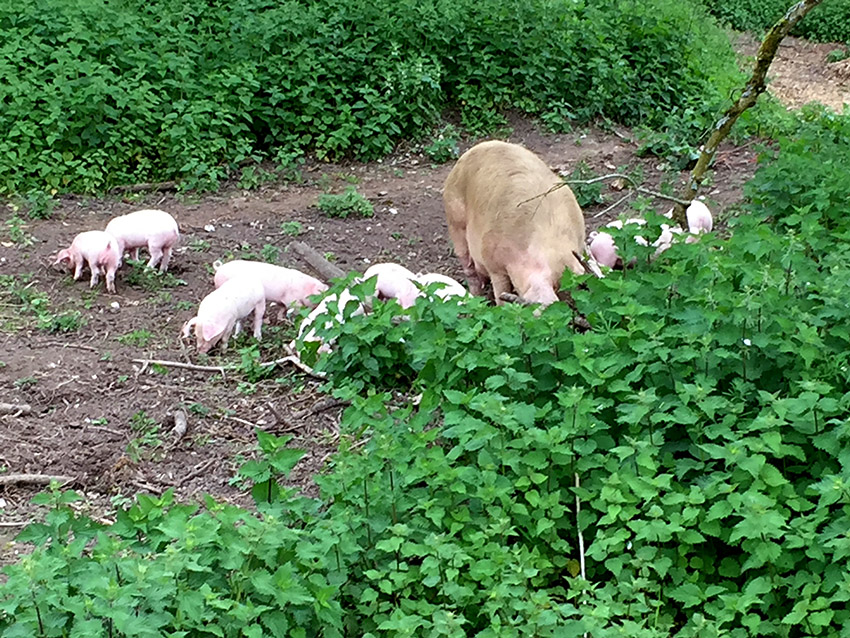
Our rare British Lops are doing well and becoming part of the seasonal cycle.
The pigs, however, were behind the orchards and on the high downland. Pigs are effectively recyclers, enjoying the kitchen peelings, the remains of orchard trees, the bounty of woodland edges as well as grains from the arable side. Our British Lop eared pigs are now again playing their part as did their predecessors. Meanwhile, the sheep grazed, and still do, on the permanent pasture. In those days, food was grown locally and menu plans had to follow the seasons. Surpluses were sold to the local grocer’s store or at market.
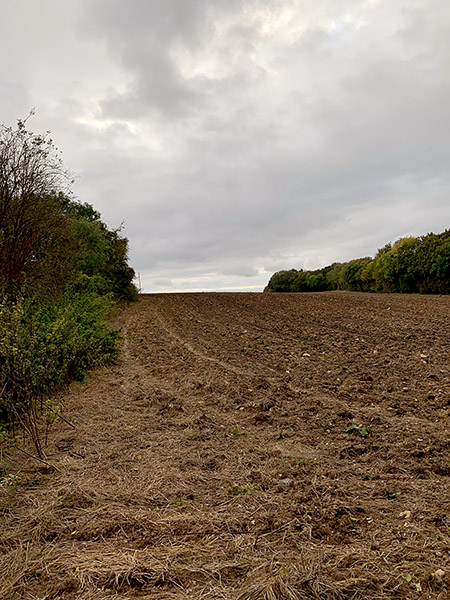
An earthy view before the miraculous green shoots..
Incidentally, in these days of carbon footprint concerns, grazing keeps carbon locked in to the earth, whereas tilling soil for crops may release carbon depending on cultivation methods and uses diesel to till and harvest. High in the skies above, the red kites slowly circle seeking the remains of dead animals, which they need to survive on. Below, insects and beetles thrive amongst the animal manure and fallen trees as these are their habitats.
Nowadays, many of us are completely unaware of the countless organisms which are involved in these complex interactions that put food from the fields onto our tables and remove our waste although our life could not continue without their assistance. Nor the fact that it is the diverse elements of our landscape, flora, fauna and livestock which leads to the production of the delicious foods we need to live and love to enjoy.
Interestingly, we are now slowly going full circle. People are querying the both the feasibility and the morality of continuing to transport food over thousands of miles and the “Eat Local” movement is growing. Understandably, if an ingredient cannot be grown locally there may therefore be a reason to fly it over or bring it in by boat. Food manufacturing techniques are also being questioned and the transparent link between field to table is slowly being re-established. Grain to cereal, or grain to glass, orchard to fruit bowl or bottle of juice, vegetables to cooking pot or salad to bowl, milk to bottle. It is in fact a rather miraculous consequence of watching seeds drilled into the waves of earthen fields that gives rise to a delicious bread, cereal or cake.
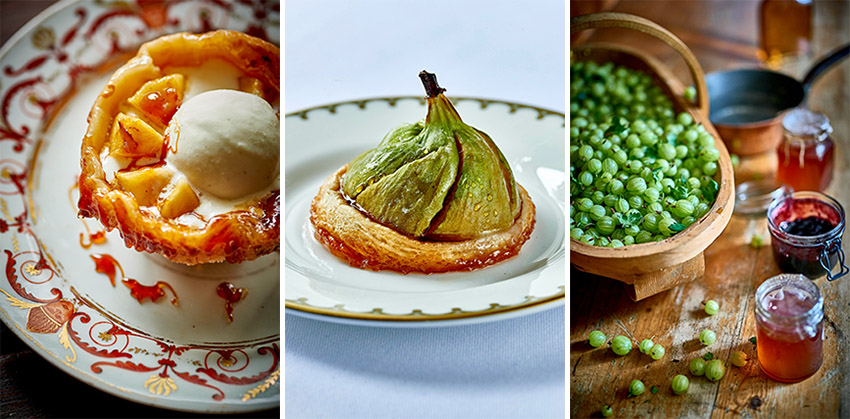
Tarte Tatin – apples from the trees, roasted figs from behind the monks garden and gooseberries and quince jelly
“Don’t judge each day by the harvest you reap but by the seeds that you sow” RL Stevenson








 Instagram
Instagram
Good morning Lady Carnarvon.
I so enjoyed sipping my morning coffee and reading your blog from across the pond. I especially enjoyed the photo of the lop eared pigs. I am familiar with lop eared rabbits but not pigs. I always learn something when I read your writings. Thank you.
Thank you – just off for coffee myself!
good morning from Vienna Austria,
while I did not have the luxury to grow up with greenhouses, I remember very well some of the practices you describe so aptly from my youth in an Austrian community.
Thank you so much for these memories your blog entry brought back to me today.. I am an absolute fan of your essays!
Greetings to all,
anna
Thank you
More & more people are becoming aware of carbon foot prints these days. I personally try to buy from local farmers at the farmer’s market. Vegetables, beef, chicken, eggs, goats milk & goat cheese, honey. (all organic of course) If I ever visit Downton Abbey…..I mean Highclare castle, I would love to see all the animals & gardens. I have always loved and am fascinated with everything about nature, right down to the bugs.(except wasps & hornets, yikes!)
I am no keen on hornets or horseflies either
The Highclere year continues with much enthusiasm, but here is your challenge.
Were there ponds nearby to provide fresh fish? I know they had them at Arundel.
When I was at Hampton Court, I noticed a swan swimming in the pool in Fountain Court.
Carry on Highclere.
There were fish ponds here, some distance from the Castle today as you need the clay not chalk
We had a small farm growing up and always had our own cattle and rabbits and chickens. And it was very hard when I got married to have to start buying that stuff in the store. You do get spoiled growing up with having a farm because it is such a pleasure to work the ground with my dad back when we were little. Beautiful article today
Thank you
What an interesting post. Surely the green house will provide a great bounty now that it is repaired. Do you know what will be planted in it? When we visit Highclere in May I hope to purchase Quince jelly if it is sold in the gift shop.
On another subject, last Wednesday the TV show, Wheel of Fortune, played a video of their visit to Highclere. One thing they mentioned was how brave you were in climbing to the top of a ladder to take the group photo.
Have a great week.
I forgot I had ! Wheel of Fortune were a great crew, fun to have here
I saw that too and loved it! Brought back memories of my visit as well!
Dear Lady Carnarvon,
I always enjoy the pictures that you include with your posts. The one of the sheep made me wonder what happens to the wool from the sheep. Is it turned into yarn? I knit with a group that has been big Downton Abbey fans and would be interested in yarn from Highclere. Last year, I learned about hair sheep. A man in Nashville, Tennessee has a herd of hair sheep. The sheep are used to clear invasive (non-native) plants in the Nashville area. People hire him to bring the sheep to an area that needs clearing. They are known as the Nashville Chew Crew, but their hair falls out and cannot be spun into yarn.
Your observations that most of us are unaware of all the aspects of growing the food we eat are spot on. The growth of the local food movement is providing new careers for many. Many years ago I saw a bumper sticker that said “Farming is everybody’s business.” It implied that if you like to eat, it’s your business too.
Thank you for the pictures, posts, and information.
Best,
Marla
I am just exploring turning our wool into yarn – it is my next project. You are right, it is all business!
Hello from Orlando, FL!
Highclere yarn is a brilliant idea! We are avid knitters with a passion for British wool. Thanks again for the wonderful opportunity to attend the Christmas Carol performance this past December.
Marla,
The Biltmore Estate (another grand house!) in North Carolina, also has hair sheep, used to keep everything nice and tidy. I had not heard of them until then.
I loved this blog! We are going to be at Highclere in the month of August for a tour and I can’t wait to see the greenhouse and everything associated!
You are so lucky – we were there last August – you will absolutely love it!!!
Awwww gooseberries. I love gooseberry pie. I have not had the opportunity to enjoy any since my childhood days. Thanks for bringing back the memories. I love the greenhouse. Have a splendid day.
I do enjoy reading your blog, thankyou for taking the time to write it.
Our trip to Highclere in 2018 was memorable, not least for the house tour and The Battle of Britain Proms. So much did we enjoy it that we have booked to come again this year and very much look forward to seeing the rebuilt greenhouse.
By the way, your Highclere gin is amazing.
Thank you ! Are you coming back to the Battle Proms again? The gin has won some very prestigious awards in the USA
Hello from Whitefish, Montana,
I do not have “waves of earthen fields” but I grow our veggies in a community garden and buy from local farmers at our weekly Farmers Market in the summertime. Bumper stickers around town ask “WHO’S YOUR FARMER?” I would love to see a photo of that same “earthy view” side by side when the “miraculous green shoots” appear. Many thanks for that R.L. Stevenson quote. I shall post it on our community garden bulletin board.
Sandie Carpenter
Thank you!
Another lovely bit of sentiment and practicality. I have always admired how the folks across the pond tend to save their structures. Whereas we, here in the US, build one and anywhere from 10-50 yrs later are razing it to the ground to build another. Personally, I believe in building for the ages.
Have a lovely day!
Horseflies can be controlled: wear a hard hat (construction helmet) our blue plastic cups to our, open side down, and coat the cups with Tangletrap or some other sticky substance. Horseflies like high places and the color blue. You notice them always flying around your head.
Typos: glue blue plastic cups to it…
This blog is the best. We will be there in August as part of a “last-hurrah” trip before our oldest goes off to college in the fall. Can’t wait.
Wonderful!
Dear Lady Carnarvon,
I am so glad there will be another Highclere restoration to check off with the greenhouse complete. Stewardship of the property is a very worthy task, and you and Lord Carnarvon definitely keep at it. Your many followers thank you, and look forward to the next project to be described.
I may have missed it, but I think you have occasionally celebrated your gardens and recycling through “farm to fork” dinners. They are not only fun and delicious, but also of strong educational measure. I would love to be a guest at one!
I know you enjoy and enjoy sharing your bounty.
Martha G.
Along with my morning cuppa tea, your beautiful post just fed me with all the delectable flavors picked precisely this morning from your freshly flourishing garden of life lived continually circular upon the fertile grounds of Highclere! Thank you!!
Dear Lady Carnarvon,
Thank you so much for sharing your lovely home with all of us. Your writings inspire me to do more with our little cabin here in the mountains of western North Carolina. Each of us is called to care for what we have been blessed with. Thank you for the reminder. Have a wonderful day!
You too thank you
I can’t wait to visit Highclere Castle, Egyptian Exhibitions, and Gardens this Summer. I enjoy reading your blog every Monday. Thanks
Your blog is such a joy to read. Thank you much for sharing.
Back to the Basics….
lest we not forget.
The way it was done for centuries is no necessarily obsolete!
Loved this blog on nature and all it provides. Makes me wish I were still teaching science. This would certainly have been the day’s lesson.
A proud shout-out from Baton Rouge, Louisiana fans of the L.S.U. 2019 COLLEGE NATIONAL CHAMPIONSHIP TEAM, a Cinderella team made up of recycled rejects who became champions.
Thank you Lady Carnavon for your post this morning. It transported me back through a host of treasured memories.
My grandmother’s family owned and worked a large farm for generations upon generations.
Such fond memories of my great grand parents and my grand parents I hold dear.
Orchards, ponds, Rolling fields, lop ears, such as yours, with many piglets in tow, chickens, ducks on the pond. Cows grazing and horses standing tall wishing to be harnessed for a ride.
Barns, each with its own purpose. Animals raised for Service, Food or Selling, like everything on a farm.
Soap. What a slice of history. A huge cast iron pot still sat in the same spot for years upon years.
The story of the making soap, still to this day, is indelible in my mind.
There was no greenhouse but there was a “kitchen garden”, a short amble from the backdoor the house. Rows upon Rows. Vegetables of every kind inside the safety of a white picket fence.
Worthy of the Wizard of Oz, there was a root cellar. Safety from a storm, safe keeping for vegetables as well as jams and jellies and a plenty of pickles all stored for winter. Canning. As a child I could not under how food preserved in glass jars could be called canned. That too was a lesson permanently stamped in my. Those dust covered empty jars once filed with the summer’s bounty sat for many many years, hoping to serve their purpose.
Lady Caranvon, your beautifully written post this morning, transported me to spendid memories. My mother grew up on that farm. While she is no longer with us, an amazing life history lesson she lived and shared.
I’d also like to mention how your Post connects people around the world. Today a lady named Marla mentioned that she was from Nashville as am I.
Disney was right, It’s A Small World After All.
Thank you 3 degrees of separation!
Good Morning, Lady Canarvon,
It is so comforting to know how lovingly you and Lord Carnarvon are restoring Highclere. How much easier it would be to just let it go and move into a lovely new home. But you respect the heritage of the Carnarvon family. Bless you. Because of your dedication we are given the opportunity to view the property and experience the beautiful castle. How much richer we are for it.
Here in Florida, they do not respect the land. They plant and plant and plant year around until the soil is so depleted it doesn’t have any nutrients left to feed the crop. Thus, our tomatoes have no flavor at all. I grew up in Ohio where a tomato tasted like a tomato, and the sweet corn was so sweet it made you drool! In the summertime of my childhood, we lived on this wonderful bounty. Our dinner table was not extravagant or grand, but it was delicious. Home grown Tomatoes, corn on the cob, grilled hamburgers, Iced tea and home grown strawberries served as Strawberry Shortcake! YUM!
Great….now I’m hungry!
This blog makes Mondays my favorite day of the week. I always read the comments to check in on the other readers…I sort of take attendance to know everyone is OK!
Until next Monday,
Linda Sue Smith
Englewood, Florida
Thank you- I think there are challenges as you describe around you and in the seas from the run off
As I read your interesting, informative blog posts, I always wonder if fate had a plan that you would be Lady Carnarvon at the time of the Downton Abbey craze when interest in Highclere is at an all time high.
It’s vitally important that intelligent, thoughtful writers document today’s way of life for historical records and future generations.
You do a smashing job!
Bonnie Bartel Latino
Alabama
Thank you Bonnie
Thrilled about the victorian greenhouse. Can’t wait to see it on my July stay.
I applaud you for the renovations you are doing. Some many would tear down and rebuild. I believe in preserving the past. I’m am also very happy that the “Farm to Table” has become again the way of life, resurrecting from the past.
Your blog is well written as always. They give me “food for thought”!
Dear Lady Carnarvon,
Your blog about greenhouses brought back many fond memories! My parents owned a greenhouse operation in Michigan, U.S.A., where the need for the region was flowers. It is too cold outside from November to May to grow anything outside. One of my best memories is getting up on a frosty, cold, and blustery winter morning, going out to the greenhouses, and seeing the burst of colors from the yellow mum’s, the red poinsettias, and the blue Dutch irises. Very uplifting!
Thank you for sharing your life at Highclere!
Thank you
Good Afternoon, Lady Carnarvon,
Let my first say how much I look forward to your posts. They immediately transport me to another world, one so harmoniously laced between the past and present. You present such inspiration! I will think of Highclere and your gardens and greenhouse as I oversee completion of my very own, proper, enclosed kitchen garden. My home is a brick Georgian and the garden is following in traditional English fashion. Finally, my husband and I are counting the days until our scheduled visit to Highclere in the second week of August when we hope to see your gardens in full glory. Keep up the great work and thanks for sharing.
You should also see the wild flower meadow too in August – it gets better every year
Good day,
I visited Highclere this September just before you closed for the season. It was lovely to see the gardens and greenhouse. I own a personnel garden maintenance business in America. I love getting my hands in the soil and creating great gardens for my clients. I would love tho have a greenhouse just for my own purposes. Perhaps when I move to England in a year or so,I can pursue that. I have dual citizenship, as my Mum was born and raised in Cheltenham. So happy that you restore history at Highclere instead of taking it down.
The best to you.
Thank you!
a lovely blog – thank you.
i grew up on 5 acres and we farmed the land so we could eat. there was no excess to sell.
i prefer soil-grown food but i cannot afford to do my shopping at local markets.
i hope you and all at “downton abbey” have a good year.
shirley taylor midwest city okla
I look forward to your blog my cousin charlie told me when the family were awayin london he use to take the horse and cart to Newbury sation with fresh produce to be delivered to family i remember the dairy cows well they all had their own names when my father stayed with his cousins he heard his cousin lewis playing farmers boy on his cornet this inspired him and he became drum major wessex ta and there regimental march was farmers boy my mum always said when the march being played no 1 in the hit parade
All the animals have their own characters – it is wonderful
Tears in my eyes as your description removed me to my childhood experiences of learning how to live in and with nature. We had goats instead of sheep; their long hair was combined with the horses’ mane/tail combings to braid into reins and ropes. I giggle at myself at times because all of my creativity began with the family motto: Use it, re-use it, repurpose it and (depending on item) make something new from it. Quilts from fabrics with feathers from poultry and leather for saddlery products & boots spring to mind immediately. The orchard and garden supplied such bounty and the canning process in such a hot kitchen which taught me how important is to plan and prepare for the future. So many memories welling up from reading your posting today- Thank you.
Memories are good to write down!
Dear Lady Carnarvon
Thank you for food for thought. The victorian greenhouse is so beautiful as well as practical. Re-use, recycle and restore! Happy Monday. Kindest regards
I always love your posts, Lady Carnarvon, and love seeing pictures of Highclere and it’s surrounding property. I wonder if you have ever heard of those Valais Black Nose Sheep? A friend of mine who has farmland and many animals, made me aware of them. I believe they are native to Switzerland, but are now in Australia – and other countries too. (I just don’t know where.) They haven’t made it to the US – yet. They are the most adorable creatures, very gentle, and look like big stuffed toys. I think you and Lord Carnarvon should consider introducing them as part of your animal menagerie, then you can post about them and let us in on what they are like. Apologies, but you will have to google them, as I am too technologically inept to send you a link!
On another subject, I wonder with all the vegetation you have, how you are able to deal with the rat population. Lovely subject, I know, but I live in a suburban wooded area, and they are problematic, especially if one has trellised or climbing vines against one’s house. I thought perhaps you may know something that I do not. Maybe you have what we in the US call “barn cats”, or cats that live outside in order to help maintain the rat population. (I sincerely hope I have not spoiled your afternoon tea by bringing up this subject.) Thank you for the wonderful post.
We try different ways to sort them !
I so enjoy your Blog each time. You make me feel like I am there with you. I live in Florida, but my heart is all British. Thank you for sharing! JoAnn Anderson
Dear Lady Carnavon,
As usual, I enjoyed this blog post immensely. A question for you – what are the ‘red kites’ that you refer to as circling in the sky? I have never heard that term before.
I had the distinct pleasure of meeting you at an event at your beautiful castle a couple of years ago, and whenever I see a new blog post from you, it brings me back to the exquisite surroundings that you inhabit – I can feel the breezes and smell the air as if it was yesterday.
All the best in the New Year to you and Lord Carnavon!
The Red Kites were under threat as a species and seem to be doing ok.. they glide over lawns and fields
After visiting your lovely home last July, I realize that your efforts to restore the land to its optimum potential is not an easy task! It is a life’s mission. Thank you and your family for taking it on.
It is a good journey…
I look forward to your words to start my week. I volunteer in greenhouses here in New England at a university so this week was dear to my heart.
I so enjoy your blogs every Monday. Since you are trying to decrease the carbon footprint have you thought of hydroponics as well? I just came back from Chena Hot Springs outside Fairbanks Alaska and they are totally self sufficient producing their own food as well as electricity having installed a Geothermal plant.
I think there will be some leaps forward in how we can source heat etc in the next five/ten years
Dear Lady Carnarvon,
Your always-elegant visual prose, whether describing holiday festivities or diurnal and seasonal agrarian tasks, brings pleasure to starting Mondays in an often stress-filled world.
I am forwarding (with credits) the photo of the grazing sheep, along with the “word picture” of the dairy herd near the walled garden, to a friend studying for exams to bring a moment’s respite…and perhaps a new Highclere enthusiast in the making!
I had the pleasure of meeting you at a Highclere Christmas Dinner as part of a Maryland Public Television visit (you were just returning from an Oxfam event but stopped in to talk with us, tired though you must have been), so the Wheel of Fortune’s Highclere video with the ever-lovely, graceful you was a very special treat!
Thank – I hope where sheep safely graze are a moment apart
Lady Carnarvon
I’m enjoying your blog and was especially interested in your latest edition.
My wife and I have recently had a life change and are learning about being self sustaining. We garden and can from a large plot, over 300 quarts last year. We’re learning about and raising our own meats as well raising pigs and chickens. We raised Yorkshire Cross pigs very successfully. The meat is so different when you raise it yourself. Our bees do their part as well.
We’re learning about composting as well to constantly improve our soil.
I feel like we are creating our own small English country estate here across the pond in New England. Thanks for sharing your thoughts and accomplishments, they provide inspiration and encouragement to improve our small bit of the world.
It sounds wonderful
Dear Lady Carnarvon, I read your writings for a long time and I am fascinated, it seems that I am facing a tale of princesses and castles. I am from Ecuador and I am a fan of yours. Thank you for those wonderful stories you publish!
Thank you
Wonderful post. Thank you. Hope to visit one day!
Lady Carnarvon,
I really enjoy reading your blog. You introduce things that I haven’t known or thought about for a long time. Thank you.
Judy Schatzle
Thank you
Is that part of an aqueduct there behind the greenhouse? Or just part of the walled garden?
My father grew up in a house in Ireland that had a walled kitchen garden. I remember as a small child being fascinated to go out with my grandmother to dig potatoes, pick berries for jam, and apples for a tart.
I love that you tell about keeping the traditions at Highclere – so much of it is lost.
Another lovely post.
Deirdre
It is part of the wall which became more ornamental 225 years ago
Dear Lady Carnarvon, I am writing to inquire about the possibilty of obtaining fleece from your sheep. I am a spinner and it would be such a pleasure to spin wool from some Highclere sheep. I would hasppily pay for said fleece and send you a skein of the yarn in return..If this seems like too much trouble I understand with all you have to do.however If you don’t ask ?? you don’t know. Thank you for your consideration. Barbara A Case Rockville, Ind USA
I am on to it – I am not sure however we can export any animal products to the USA!
The tarte tatin looks delicious! Lovely post.
The greenhouse is magnificent! It must feel wonderful to repair/rebuild something that was such an important part of your home’s history. I enjoyed your post and all the information you shared.
Dear Lady Carnarvon, Thank you for adding to my enjoyment of planning my travel to London in May.
Just think how the Series Dowton Abbey has opened up a whole world of education for me. I look forward with great anticipation my up coming visit to London and my day tour to Highclere. You have been very generous with your information on daily life and history. I especially like the way you have restored the greenhouse, respecting the way nature would have us enjoying all its benefits which can be taken for granted by some.
I saw this anonymous quote that suits…” there is no time to be bored in a world so beautiful” thank you for the graciousness of you and your family. For in doing such sharing has enriched me.
Maria
Thank you – you are right – I am not bored!!!
Lady Carnarvon, Both of my comments are still being wiped of the page. Going to try one more time and hope for the best. Is there any chance you are coming to Canada this year. It would be wonderful if it was Edmonton Alberta. I live about 1 hour away. Have a joyful day.
I would love to return and explore our relationship
I am in complete agreement with your concerns about our carbon footprints. The “farm to table” movement is so good for our planet! I visited Polyface Farms, a family owned multi-generational, pasture-based farm in the Shenandoah Valley of Virginia and was impressed with their non-industrial food production oasis. Am eager to see Highclere’s production. Our group is planning a trip to England in October and we are eagerly awaiting the posting of events in October at Highclere. We refuse to book our tickets for England until we know when we can visit Highclere!!
Wonderful – we will post the October dates soon I am just trying to sort VE Day at the moment and run out of head space!
Thank you for this informative article. I’ve learned much from this and your other blogs. The Victorian era is the most interesting to me.
Lady Carnarvon, I put in the post a greeting card for you. I hope it arrives to you safely as our mail in my home town of Calmar can have problems. Hope your day is going well.
Thank you – I will let you know
Lady Carnarvon,
“The Circle of Life”
Repair, replace, rebuild you never know what you are going to run into until you start tackling that project. You just take a deep breath. . .and forge ahead (:
I would rather eat local food grown, it taste more favorable.
And livestock.
Thanks for sharing the quote. It was spot on.
Phyllis
Thank you for your blogs love reading then we will be over to visit you at the end of August looking forward to it am from Australia thanks
Thank you!
Good Afternoon/Evening. Always such a good read and so interesting, thank you. I started your new book, Christmas at Highclare the other day. My husband and son gave it to me for Christmas. Yes it took time to get to reading it…I must confess I read the other book they got me first… Downton Abbey, the Official Film Companion. What I’ve read so far is wonderful, as are your blogs. Take care and have a good weekend.
Thank you.
Connie
Dear Lady Carnarvon,
I really enjoying reading what you write. It is so interesting and I always learn something and your way of writing is almost like a melody.
I love the quote….
“Don’t judge each day by the harvest you reap but by the seeds that you sow” RL Stevenson
Thank you.
Jennifer Graham
Kitchener, Ontario, Canada
Good afternoon Lady Carnarvon,
this is slightly off topic but for the past 30 days I have been enjoying your latest book, Christmas at Highclere. It has become a small indulgent ritual to make myself a cup of coffee or tea and to sit down and slowly read each word, enjoy each picture and just enjoy the feel of my beautiful book. Thank you for such a lovely book, which was a Christmas gift from my husband. I can now catch up on my Victoria magazine.
Kindest Regards,
Maru Kramer
North Carolina, U.S.A.
Thank you – I so enjoyed writing it!
I enjoy reading your blog. Thank you for taking time to write, as I am sure you are fully occupied! I too love the farm fresh vegetables, and have taught my sons to cook from the fresh as much as possible. My parents were farmers, until WWII, then they always kept a garden. If there was too much, fruit or veg, my father would sell it to the local grocers. I have his green thumb, and fresh tomatoes always call my name. I will never visit your home, but have enjoyed seeing it in the series, and hearing about it. I would like to buy your book, Christmas at Highclere. It sounds wonderful.
Thanks so much,
Jean Teague
Texas, U.S.A.
My husband loves tomotoes – we always grow them in the grrenhouses!!!!
I love reading your blog!
Your subjects are interesting and articles so beautifully and thoughtfully written.
Thank you for supplying us with earth friendly ideas to ponder.
Sincerely,
Susan Ross
Oregon
USA
Thank you
Lady Carnarvon, I just started subscribing to your blog. I am pleasantly surprised to see you answer all comments! That says something about you! ❤️ I live in the US and am a chef with a Supper Club! So, I am going to enjoy following you, reading about your home and especially your recipes!
Laura
DFW, USA
Welcome and please do let me know which of my recipes are favourites at your supper club.